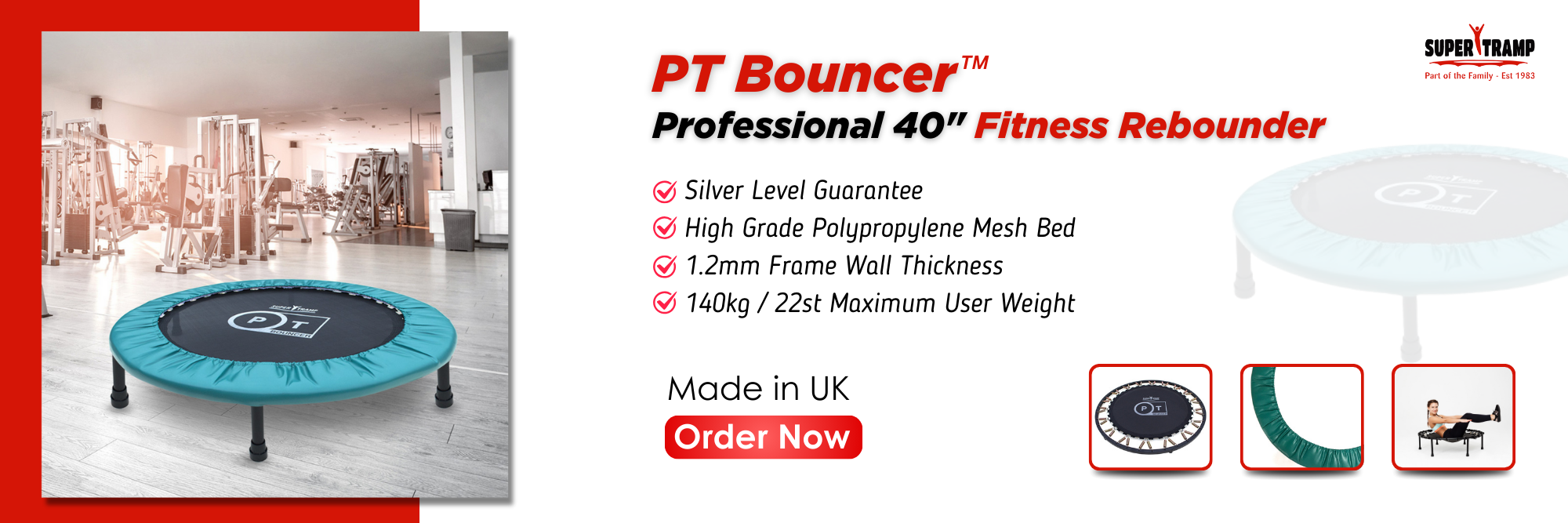
When it comes to choosing a fitness activity, there’s a wide array of options available, each offering its unique benefits and challenges. Among these, two activities often stand out due to their popularity and accessibility: trampoline jumping and running. Both are praised for their health benefits, but they differ significantly in terms of execution, impact on the body, and the type of workout they provide.
Table of Contents
ToggleTrampoline jumping, often considered as a fun and exhilarating activity, involves bouncing on a trampoline, utilizing the springy surface to perform various exercises and movements. This activity is noted for being low-impact, making it easier on the joints compared to many other forms of cardiovascular exercise.
Running, on the other hand, is one of the most common forms of physical activity worldwide. It requires no special equipment beyond a pair of running shoes and can be done almost anywhere. Known for its high-calorie burn and cardiovascular benefits, running is a go-to exercise for many looking to improve their fitness.
Given these characteristics, a key question arises: Is trampoline jumping better than running? Here we are with a presentation that aims to delve into this question by comparing the benefits and drawbacks of each activity. We will explore which of these might be more beneficial for overall health and fitness, considering various factors such as safety, accessibility, and the physical benefits provided. By the end of our discussion, we hope to provide a clearer picture of how each activity stands in terms of enhancing your health and well-being.
Understanding Trampoline Jumping

Trampoline jumping is an activity that involves bouncing on a trampoline, using its elastic surface to execute a range of movements and exercises. This can vary from simple, low-intensity bouncing to complex, high-intensity acrobatics and aerobics. Trampolines themselves come in several types, each suited for different settings and purposes:
- Mini-trampolines are typically used at home or in a gym for personal fitness routines.
- Larger recreational trampolines are often found in outdoor settings and are popular among children and adults for more vigorous jumping and recreational use. For example:- Playground trampolines, Garden trampolines etc.
Physical Benefits
Trampoline jumping offers several notable health benefits:
- Cardiovascular Health: Regular use of a trampoline can increase heart rate and improve circulation, similar to other forms of aerobic exercise.
- Low Impact on Joints: The trampoline’s soft, elastic surface reduces the impact of exercise, making it easier on your ankles, knees, hips, and spine.
- Improvement in Balance and Coordination: Navigating the unstable surface of a trampoline requires constant adjustments in body position, which can enhance motor skills and balance over time.
- Mental health benefits: Trampoline jumping has been shown to have positive effects on mental health, including stress reduction, mood enhancement, and increased general mental well-being. These advantages are related to positive effects on emotional well-being and cognitive performance.
Potential Risks
Despite its benefits, trampoline jumping does come with risks:
- Injury Risks: These can include sprains, fractures, and other injuries resulting from falls on the trampoline itself, falling off the trampoline, or colliding with another person.
- Precaution measures: These can include using trampoline accessories like- trampoline socks, safety nets, trampoline ladders etc.
Trampoline jumping is praised for being a calorie burner. It is less taxing on the joints than high-impact activities like running. Learn more
Understanding Running

Running is a versatile and accessible form of exercise embraced by fitness enthusiasts around the world. It comes in several forms, each suited to different fitness objectives and preferences:
- Sprinting: This style involves running at full speed over short distances. It primarily focuses on developing power and speed, engaging fast-twitch muscle fibers for quick bursts of energy.
- Long-distance Running: Including activities like marathons and half-marathons, this type emphasizes endurance, aerobic capacity, and mental perseverance over courses that challenge one’s stamina.
- Casual Jogging: Less intense than sprinting or long-distance running, jogging is preferred for maintaining fitness, improving cardiovascular health, and enjoying physical activity without high stress.
Physical Benefits
The benefits of running are substantial and well-documented:
- Strong Cardiovascular Benefits: Regular running increases heart rate and lung capacity, strengthens the heart, improves circulation, and significantly lowers the risk of cardiovascular diseases.
- Efficient Calorie Burning: As a high-intensity exercise, running is highly effective at burning calories, which can help with weight loss and energy balance.
- Muscle Building and Maintenance: Running helps build muscular strength, particularly in the lower body, including the legs, hips, and core muscles.
Potential Risks
Despite its benefits, running carries potential downsides that athletes should be aware of:
- Higher Impact on Joints: Running’s repetitive impact, particularly on hard surfaces, can lead to joint stress and accelerated wear, raising the risk of arthritis in the knees, hips, and ankles.
- Risk of Overuse Injuries: Frequent runners may experience overuse injuries such as shin splints, Achilles tendonitis, and iliotibial band syndrome, which occur from repetitive strain without sufficient recovery.
Comparative Analysis

Now let’s compare trampoline jumping and running, focusing on key aspects such as caloric expenditure, safety, accessibility, and mental health benefits. This comparison will help us determine which activity might suit different fitness goals and lifestyles better.
Comparison of Caloric Expenditure
- Trampoline Jumping: Generally burns fewer calories per minute compared to running, but it can still offer a significant burn, especially in vigorous or high-intensity trampoline workouts.
- Running: Known for its high caloric burn, running, particularly at higher speeds or over longer distances, can consume a substantial number of calories. The exact burn rate depends on the speed, body weight, and running efficiency.
Safety Comparison
- Trampoline Jumping: While generally low-impact, which is easier on the joints, trampoline jumping does carry a risk of falls or collisions, especially if safety guidelines are not followed.
- Running: Carries a higher risk of joint wear and overuse injuries due to its high-impact nature. Proper shoes and running techniques are critical to minimize these risks.
Accessibility and Convenience
- Trampoline Jumping: Requires a trampoline, which can be a significant initial investment and requires enough space for safe use. Once set up, it’s readily accessible for use.
- Running: Highly accessible and convenient as it can be done almost anywhere without special equipment, except for a pair of good running shoes. Ideal for those who prefer a straightforward approach to exercise without needing specific facilities.
Mental Health Benefits
- Trampoline Jumping: Offers stress relief and improves mood through fun and playful activities. The act of jumping can be inherently joyful, providing mental as well as physical exercise.
- Running: Highly effective at reducing stress, anxiety, and depression. The “runner’s high,” a state of euphoria that occurs due to the release of endorphins during intense exercise, is a significant mental health benefit.
This comparative analysis allows us to see not just the physical, but also the practical implications of choosing one form of exercise over another, helping you make an informed decision based on your personal health, safety, and wellness goals.
Now What Should You Decide?

Choosing between trampoline jumping and running for your fitness regimen is more than just a matter of preference—it’s about aligning the activity with your personal health goals, physical condition, and lifestyle. Here’s a dynamic way to help guide your decision:
Define Your Fitness Objectives:
- Calorie Burn & Endurance: If this is your priority, think about running. How do you feel about integrating running into your daily routine?
- Low-Impact & Fun: Prefer something gentler on the joints with a fun factor? Consider how trampoline jumping might fit into your weekly schedule.
Evaluate Your Physical Health:
- Existing Injuries or Joint Concerns?: Could trampoline jumping serve as a safer alternative to your current routine?
- Looking to Boost Physical Health Robustly?: If you’re aiming for improved bone density and overall physical toughness, would you be interested in regular running sessions?
Logistical Considerations:
- Accessibility: Do you have easy access to a safe running path or a gym with a trampoline? Could investing in a trampoline be feasible for your home and lifestyle?
- Interactive Planning: Let’s sketch out a potential weekly plan for each activity. Who would be able to consistently integrate running into their weekly routine? Who could do the same with trampoline jumping?
By making this session interactive, you not only get a deeper understanding of each exercise’s benefits but also engage actively with your fitness choices, making the decision process as informative and enjoyable as possible. Consider incorporating both activities for a varied and comprehensive fitness regime, tailoring the frequency to suit your specific needs and capabilities.





